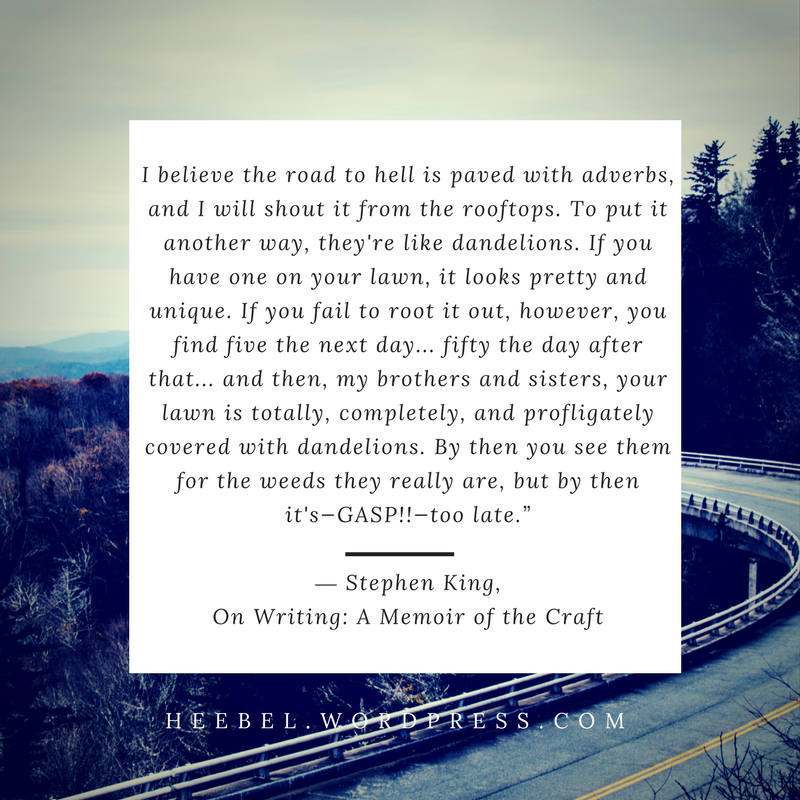You know those memes that show two pictures – one of what you think you look like when doing xyz and one of what you actually look like when doing xyz? That’s the way I feel sometimes when writing. My story is clear in my mind, but when someone else reads it, the picture gets blurred or becomes something else.
The author will never be able to paint a picture with words perfect to what the reader sees in their mind, but there are ways you can help bridge the gap between author and reader. Every reader brings their own imagination, viewpoints, and experiences with them, and you can use this to your advantage to make the reader’s experience more vivid. The following are a list of writing tips I’ve used in my own writing to help paint a clearer and more vibrant experience for my reader.
1. Don’t waste words describing every single detail to your reader. More description does not equal more vivid. Some writers feel the need to describe everything from the color of the carpet to the popcorn ceiling and then wonder why their word count is 100k more than what’s recommended for their genre. Perhaps you don’t have this problem, but if you find yourself slipping in several sentences of description on a single character you may want to think of a way to cut back.
|
Here are some quick examples: Example #1 – Susan wore red, white, and turquoise, tie-dye bell-bottoms. A brown, fringe vest hung over her shoulders on top of a red shirt. Around her neck hung a gold chain with a brown, wooden peace sign pendant. Result – You’re probably either confused or lost by trying to keep track of all those colors. {I’m confused by this wordiness, and I saw a picture of Susan.} Example #2 – Susan looked like she stepped from the pages of a 70’s yearbook. Result – You probably pictured a 70’s outfit you’ve seen before. The colors are probably all wrong, but it doesn’t matter because the outfit is distinct in your mind. {I have one in my head now and in my opinion, it’s a better outfit than Susan’s real one.} |
2. Don’t waste words describing the obvious or uninteresting to your reader. So maybe you don’t have the overwhelming desire to describe every square inch of each of your characters and their world, but the description you do have might be unnecessary.
For example, do you really need to say the box the UPS driver just left on the porch is brown? That the light is bright, and the book on Bill’s desk has paper pages. And also the calico cat has stripes, plus fur, whiskers, and claws.
I’m exaggerating a bit, but when proofreading your descriptions ask yourself – Would my reader be able to picture something like this without me including these details? If so, delete it, and use that word space for more vivid descriptions like the ones described in the next tip.
3. Fill your descriptions with distinct details. The details you include in your descriptions should be things the reader wouldn’t picture unless you told them. The things that make what you are describing unique.

|
Example: Picture a barn. There are 1,000s of different types of barns in the world, but likely you had something come up in your mind. A blueprint of some kind of barn you’ve seen before. I could attempt to describe the barn in my mind perfectly to you. I could tell you the dimensions, color, number of windows and doors, and material the roof and exterior was made of. But most of those things are boring, unless for some reason those features aren’t boring because they are unique. Boring: – I stood in front of a massive red barn whose aluminum panels reflected in the sun. – I stood in front of a wooden out-building with a wide opening in the front for large farm equipment to drive through. More Interesting: – I stood in front of a barn with white, peeling paint whose roof sunk in from the broken windmill that leaned against it. – I stood in front of a barn enclosed with glass walls and a thatched roof covered in solar panels. |
Now, obviously you can’t go throwing glass walls on buildings that don’t make sense to have them, but the important thing is to seek out the interesting in your scene and describe those things with distinct details. Leave the boring and non-specific things out.
4. Focus on including details you could capture through the lens of a video camera and omit most of the rest. If you want your reader to feel as if they are in the scene, create the scene around them and leave them there to experience it. Don’t rip them out to plunge them into backstory, or interrupt what’s going on to inform the reader that the character who just punched a hole in the wall is feeling angry.
If you haven’t yet heard the terms “show don’t tell”, be prepared to hear them hundreds of times over throughout your writing career. Hearing the terms is one thing, making sure not to do it is another. I didn’t feel like I fully understood the terms until I read this article by Roseann Biederman. I love her “camera test” technique and use it frequently when making revisions.
5. Imply emotions, don’t explicitly state them. If you want your reader to feel emotions along with your characters, you must create scenes that evoke emotion. You don’t do that by stating “Mary was sad” or “Bob was scared”. You don’t bring tears to your reader’s eyes by telling her “Mary cried”, and you don’t put your reader’s hair on edge by telling him “Bob’s heart thundered inside his chest.” Yes, you may be successfully sharing what your characters are feeling, but you’re not allowing your reader to experience those emotions alongside your characters.
For your reader to experience Mary’s sadness, you must describe a scene that unfolds the source of Mary’s sadness. If you do it well enough, the reader will be crying right along with Mary by the end of the scene. And if you want your reader to experience Bob’s fear, you must immerse her into a scary scene.
The next time you’re reading a book that brings you to tears, note what the author did to bring you to that place. Did they ever even use the word sad or explicitly state what emotions were being felt? What about the book that puts you so on edge you’re scared to turn the page? Pay attention to what works to bring out your own emotions when reading and try to duplicate those aspects in your own writing.
Here’s a post that speaks on this tip in more detail – Easy Strategies to Evoke Emotion in Your Writing
6. Replace adverbs with stronger verbs. In most cases, you don’t need adverbs, and they weaken your writing. Read the following excerpt below to see what Stephen King thinks of adverbs:

|
Here’s a quick example of two groups of sentences, one with adverbs (bolded) and one without. With Adverbs: The boy angrily took off his hat and threw it hard against the fence. He walked slowly back to the dug-out sluggishly dragging his cleats through the dirt. Without Adverbs: The boy ripped off his hat and hurled it against the fence. He sludged back to the dug-out dragging his cleats through the dirt. |
I use http://www.thesaurus.com/ when I’m looking for a stronger verb. I do this do help jog my memory on a word that will fit what I’m looking for. Word of caution! – Don’t do this to dig up obscure words you’ve never heard before in attempt to make your writing sound smarter. People don’t want to weed through jargon, and you don’t want to be embarrassed when the word doesn’t mean what you thought.

(Unsure what adverbs are? Click here for a definition or click here for a list of common adverbs).
Thanks for reading! I’d love to hear your thoughts and to connect with you. What are some strategies you use to help make your writing more vivid? Leave your ideas in the comment box below!
Did you enjoy? – Any likes make me smile 🙂 , and any shares make my day ❤ .
If you enjoyed this post – Check out my post on filter words as well – A Few Easy Strategies to Remove Those Pesky Filter Words That Fog Up Your Writing
Solid advice. As an editor, these are some very common mistakes I see people make, especially on the lack of valuable detail and overabundance of unnecessary detail. Great article!
LikeLiked by 2 people
Clever post.
I can’t say I disagree with any of it.
There are times, though, when writing for a certain effect, usually, humour, an absurdly, creatively, uniquely profound string of adverbs can go a long way towards lightening the mood and planting a nice, wide grin on your reader’s face.
Enjoyed reading your tips.
LikeLiked by 1 person
Haha…it put a grin on my face! Thanks for the lovely comment. Glad you enjoyed!
LikeLike
Fana-tasticcc. Useful advice! Totally agree with all the 6tips especially using strong verbs instead of adverbs. We all learn from each other. Thanks again.
LikeLike
Great post! The part about adverbs was especially helpful to read, because that is something I struggle with, especially in fast-moving scenes.
LikeLike